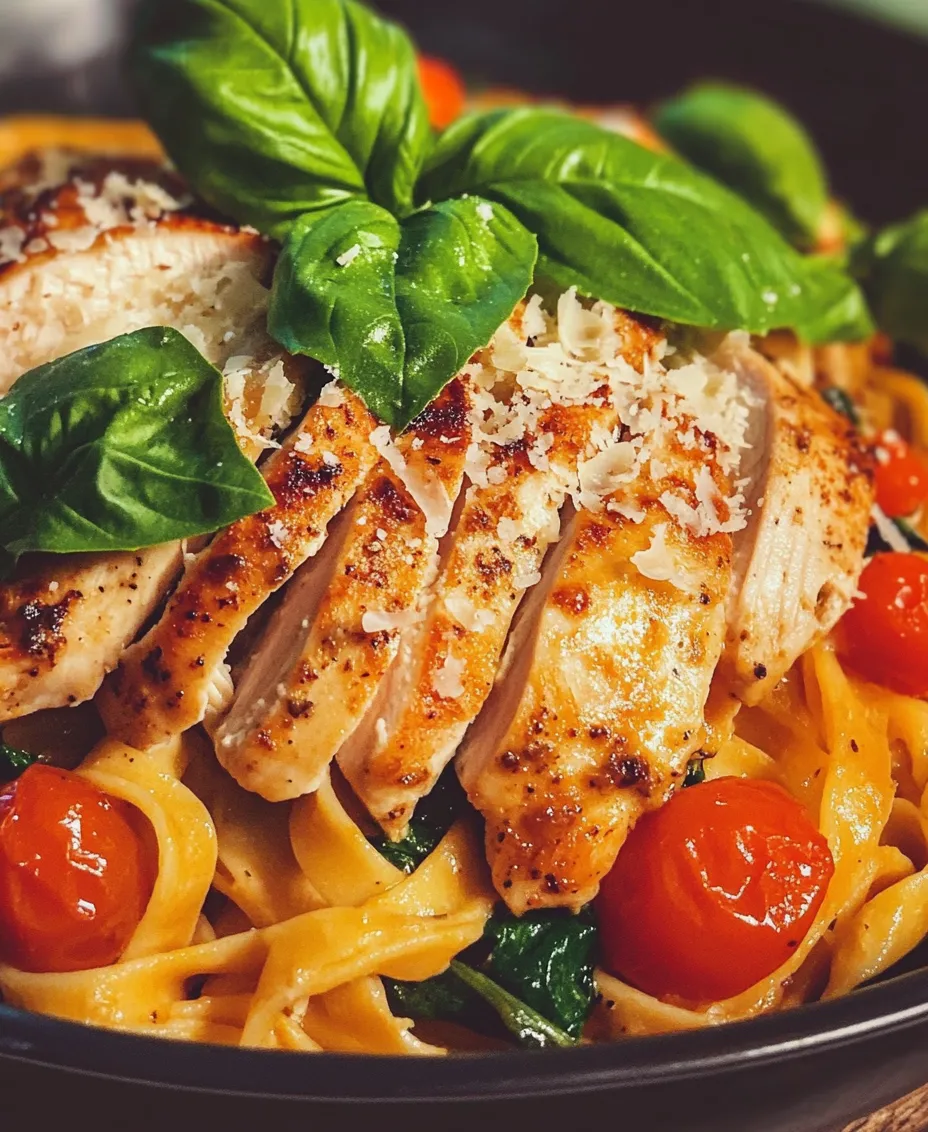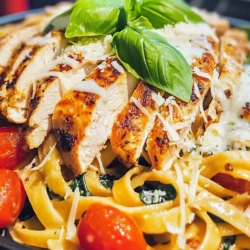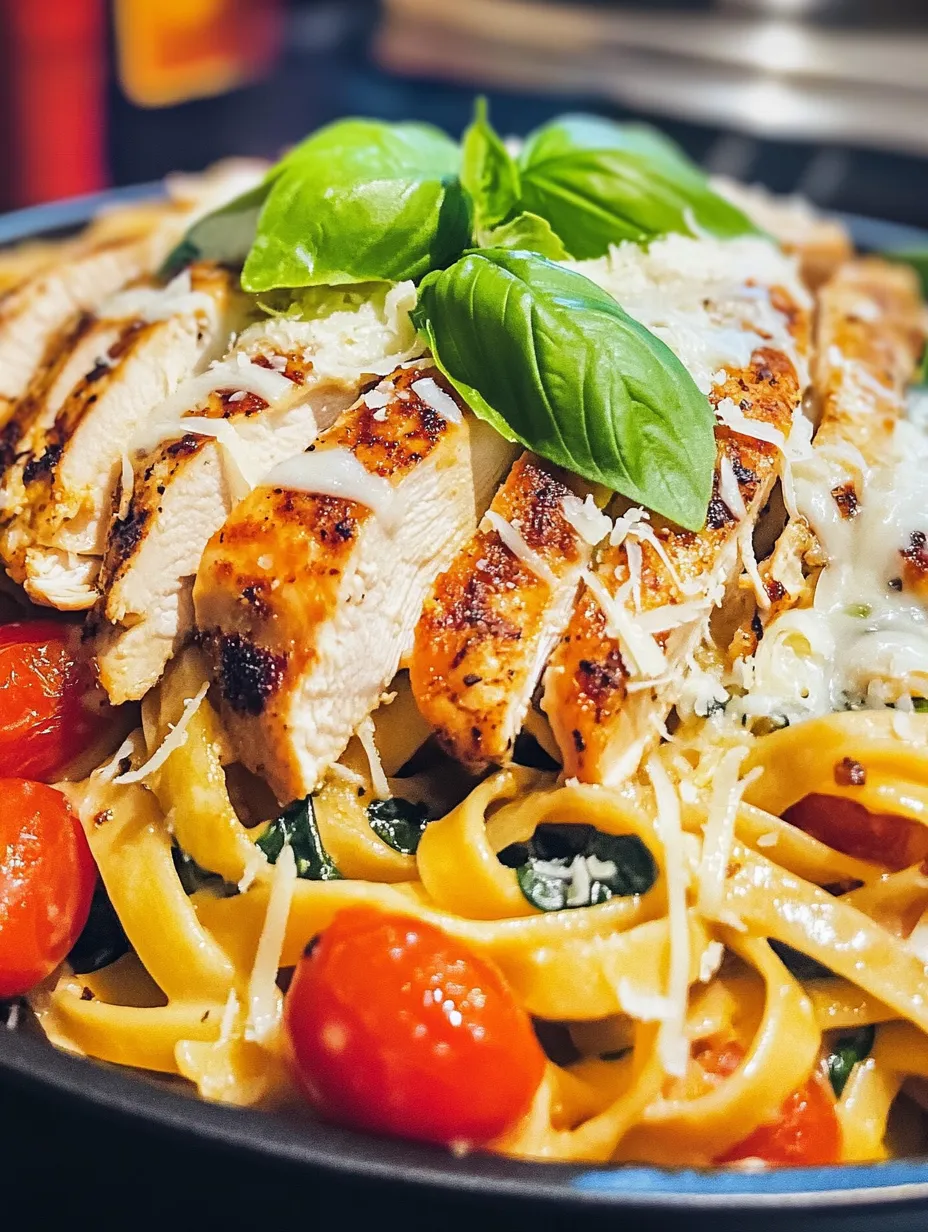Introduction
When it comes to comfort food that also brings a touch of elegance to the table, Creamy Tuscan Chicken Pasta shines brightly. This dish masterfully combines the rich and savory flavors of Tuscany with the hearty satisfaction of pasta, creating a meal that is both fulfilling and indulgent. Italian cuisine, celebrated worldwide for its vibrant flavors and wholesome ingredients, has a special place in the hearts of many food lovers. Among its myriad offerings, Creamy Tuscan Chicken Pasta stands out, not just for its creamy texture but also for the colorful array of ingredients that come together to create a delightful experience for the palate.
The popularity of this dish can be attributed to its versatility and ease of preparation. Whether you are looking to whip up a quick weeknight dinner or impress guests at a special gathering, this recipe is a perfect choice. The combination of tender chicken, al dente fettuccine, and a luscious cream sauce, infused with aromatic herbs and fresh vegetables, makes it a crowd-pleaser. As we delve into the process of creating this delightful meal, you’ll discover how simple it is to bring a taste of Italy into your kitchen.
Understanding the Ingredients
To achieve the perfect Creamy Tuscan Chicken Pasta, it’s essential to understand each ingredient’s role in the dish. Here’s a closer look at the key components that contribute to the flavor and nutrition of this recipe.
Overview of Chicken Breasts
The foundation of this dish begins with boneless, skinless chicken breasts. This choice is not only favored for its lean protein content but also for its versatility in cooking. Chicken breasts are lower in fat compared to other cuts, making them a healthier option for those looking to maintain a balanced diet. Additionally, their mild flavor allows them to absorb the spices and sauces beautifully, ensuring every bite is packed with taste. Cooking chicken breasts properly results in tender, juicy meat that perfectly complements the creamy pasta sauce.
The Role of Fettuccine Pasta
Fettuccine pasta is particularly well-suited for creamy sauces due to its flat, broad shape, which allows it to hold onto the sauce effectively. This traditional Italian pasta is made from egg and flour, providing a rich flavor and a delightful texture. Cooking the pasta al dente is crucial; this means it should be firm to the bite and not overly soft. Al dente pasta will not only enhance the dish’s texture but also provide a perfect balance with the creamy sauce, ensuring a satisfying chew with each forkful.
Olive Oil: A Flavor Foundation
Olive oil is often referred to as the backbone of Italian cooking. Its rich flavor profile and health benefits make it an essential ingredient in this recipe. Extra virgin olive oil, in particular, is known for its high content of monounsaturated fats and antioxidants, promoting heart health and reducing inflammation. In this dish, olive oil is used to sauté the chicken and vegetables, enhancing their flavors while providing a light and healthy base for the creamy sauce.
Garlic: The Aromatic Essential
Garlic is a staple in Italian cuisine, known for its aromatic qualities and robust flavor. It adds depth and warmth to the dish, making it more inviting and complex. Beyond its culinary uses, garlic is celebrated for its numerous health benefits, including potential immune-boosting properties and anti-inflammatory effects. In Creamy Tuscan Chicken Pasta, fresh minced garlic infuses the oil with a fragrant aroma that sets the stage for the other ingredients to shine.
Fresh Vegetables: Cherry Tomatoes and Spinach
The addition of fresh vegetables like cherry tomatoes and spinach not only enhances the dish’s nutritional value but also adds vibrant colors and contrasting textures. Cherry tomatoes, with their natural sweetness, provide a pop of flavor and a juicy bite that complements the richness of the creamy sauce. They are also an excellent source of vitamins C and K, as well as antioxidants. Spinach, on the other hand, is packed with nutrients, including iron and calcium, making it a fantastic addition to any meal. Its mild flavor and tender leaves wilt beautifully into the sauce, contributing both nutrition and visual appeal.
Heavy Cream and Parmesan Cheese
The luxurious creaminess of this dish comes from a combination of heavy cream and grated Parmesan cheese. Heavy cream, with its high-fat content, creates a rich and velvety sauce that envelops the chicken and pasta, making every bite indulgent. Parmesan cheese adds a salty, nutty flavor that enhances the overall taste of the dish. For those looking for alternatives, options like half-and-half or non-dairy cream can be used, but the texture and richness will vary.
Italian Seasoning: A Blend of Flavors
To truly capture the essence of Italian cuisine, a blend of Italian seasoning is essential. This mixture typically includes dried herbs such as oregano, basil, thyme, and rosemary, each contributing unique flavors to the dish. The use of Italian seasoning in Creamy Tuscan Chicken Pasta not only enhances the overall flavor profile but also evokes the aromatic scents of a traditional Italian kitchen. A sprinkle of this seasoning elevates the dish, bringing all the ingredients together in harmonious balance.
Step-by-Step Preparation Guide
Creating the perfect Creamy Tuscan Chicken Pasta requires careful preparation and attention to detail. Below, we’ll walk through the initial steps of this delightful recipe, ensuring clarity for cooks of all skill levels.
Cooking the Pasta: Perfect Techniques
The first step in this culinary journey is to cook the fettuccine pasta. Begin by bringing a large pot of salted water to a rolling boil. The salting of the water is crucial as it enhances the pasta’s flavor as it cooks. Once the water is boiling, add the fettuccine, stirring gently to prevent sticking.
Cook the pasta according to the package instructions until it is al dente. This typically takes around 8 to 10 minutes, but it’s important to taste the pasta a minute or two before the suggested cooking time to ensure it reaches the desired texture. After draining the pasta, it’s beneficial to reserve a cup of the pasta water. This starchy water can be added later to adjust the sauce’s consistency, creating a silkier texture that clings beautifully to the noodles.
Preparing the Chicken: Seasoning and Cooking
While the pasta cooks, it’s time to focus on preparing the chicken. Start by patting the boneless, skinless chicken breasts dry with a paper towel. This step is essential for achieving a nice sear when cooking. Season both sides of the chicken breasts generously with salt, pepper, and a sprinkle of Italian seasoning for added flavor.
In a large skillet, heat a couple of tablespoons of olive oil over medium-high heat. Once the oil is shimmering, carefully add the seasoned chicken breasts to the pan. Allow them to cook undisturbed for about 6 to 7 minutes on one side, until golden brown. Flip the chicken and continue cooking for an additional 5 to 6 minutes, or until the internal temperature reaches 165°F (75°C). This ensures that the chicken is fully cooked and juicy.
Once the chicken is cooked through, transfer it to a cutting board and let it rest for a few minutes. This resting period allows the juices to redistribute, resulting in tender slices. After resting, slice the chicken into strips, ready to be combined with the pasta and sauce.
—
This introduction and initial preparation guide set the stage for an exquisite culinary experience. By understanding the key ingredients and following the careful preparation steps, you are well on your way to creating a memorable dish that celebrates the flavors of Tuscany. Stay tuned as we continue to explore the remaining steps of this delightful recipe!

Creating the Sauce: Techniques for Success
The sauce is the heart of any creamy Tuscan chicken pasta, and nailing the right consistency is essential for a successful dish. Begin by heating olive oil in a large skillet over medium heat. Add minced garlic and sauté for about one minute, or until fragrant—be careful not to let it brown, as burnt garlic can impart a bitter flavor. After this, pour in the heavy cream, stirring continuously to create a smooth base.
Next, gradually add in the chicken broth, allowing it to blend seamlessly into the cream. This step is crucial; adding the broth too quickly may cause the sauce to become watery instead of rich and creamy. To enhance the flavor further, stir in grated Parmesan cheese, Italian seasoning, and a pinch of red pepper flakes for a touch of heat, if desired.
For the best results, let the sauce simmer gently for about 5-7 minutes. This allows the flavors to meld together and the sauce to thicken slightly. If you’re looking for a thicker sauce, you can simmer it for a few additional minutes, but remember to keep an eye on the heat to prevent any burning.
Combining the Ingredients: Achieving Harmony
Once your sauce has reached the desired consistency, it’s time to combine the pasta, chicken, and sauce. First, ensure your pasta is cooked al dente according to package instructions. Reserve a cup of pasta water before draining, as this starchy liquid can help adjust the sauce’s consistency if needed.
In the skillet with your creamy sauce, add the cooked chicken pieces. Gently mix them in, allowing them to soak up the flavors. Then, add the drained pasta to the skillet, tossing everything together carefully. Use a pair of tongs or a large spoon to combine the ingredients without breaking the pasta or chicken. If the sauce seems too thick, gradually add some reserved pasta water until you achieve your preferred creaminess.
To finish off the dish, fold in a handful of fresh spinach and sun-dried tomatoes. The spinach will wilt beautifully in the warm sauce, adding both color and a nutrient boost, while the sun-dried tomatoes will provide a burst of tangy flavor that complements the creaminess perfectly.
Serving Suggestions: Presentation Matters
Presentation can elevate your creamy Tuscan chicken pasta from simple comfort food to an impressive meal. Start by plating the pasta in a large serving bowl or individual plates. For an elegant touch, twirl the pasta into a nest shape using a fork or tongs, allowing the sauce to cascade around the edges.
To enhance the dish visually, top it with freshly chopped basil leaves. The vibrant green of the basil not only adds a pop of color but also a fresh, aromatic component that ties the dish together. You can also sprinkle additional grated Parmesan cheese over the top for a decadent finish, and if you like a bit of crunch, consider adding toasted pine nuts or walnuts as a garnish.
Nutritional Information
Understanding the nutritional content of your meals is essential for maintaining a balanced diet. For a standard serving of creamy Tuscan chicken pasta, you can expect the following approximate nutritional values:
– Calories: 550
– Protein: 30 grams
– Fats: 30 grams
– Carbohydrates: 45 grams
This dish can fit into a balanced diet when consumed in moderation. The protein from the chicken aids in muscle repair and growth, while the carbohydrates from the pasta provide the energy required for your day. However, if you’re watching your calorie intake, consider serving a slightly smaller portion alongside a fresh salad to balance your meal.
Culinary Variations and Substitutions
One of the beauties of creamy Tuscan chicken pasta is its versatility. Let’s explore how you can modify the recipe to suit different dietary needs or personal preferences.
Gluten-Free Options
For those following a gluten-free diet, the good news is that there are many pasta alternatives available. Look for gluten-free pasta made from rice, quinoa, or lentils. These options maintain a delightful texture and flavor, so you won’t sacrifice taste while making your dish accessible.
Dairy-Free Alternatives
If you want to make this dish dairy-free, you can replace the heavy cream with full-fat coconut milk or a plant-based cream alternative. Nutritional yeast can serve as a substitute for Parmesan cheese, providing a cheesy, umami flavor without the dairy. Be sure to check the labels to avoid any added sugars or unwanted ingredients.
Adding More Vegetables
To increase the nutritional value of your creamy Tuscan chicken pasta, consider incorporating additional vegetables. Bell peppers, mushrooms, or zucchini can be sautéed alongside the garlic at the start of the sauce preparation. These veggies not only add color and texture but enhance the dish’s flavor profile, making it even more delightful.
Pairing Suggestions
To create a complete dining experience, consider pairing your creamy Tuscan chicken pasta with complementary side dishes and beverages.
Side Dishes
Garlic bread is a classic accompaniment to pasta dishes, perfect for soaking up any leftover sauce. A simple mixed green salad dressed with balsamic vinaigrette adds a refreshing contrast to the richness of the pasta. Roasted vegetables, seasoned with olive oil and herbs, can also bring an additional layer of flavor and nutrition to your meal.
Wine Pairings
When it comes to wine, white wines such as Sauvignon Blanc or Pinot Grigio work beautifully with creamy dishes. If you prefer red, a light-bodied wine like Pinot Noir can enhance the meal without overpowering the flavors of the pasta. Serve the wine chilled for white or slightly cooler than room temperature for red to ensure the best tasting experience.
Conclusion
Creamy Tuscan chicken pasta is more than just a meal; it’s an experience that brings the flavors of Italy right to your dining table. This versatile dish is simple enough for a weeknight dinner yet impressive enough for gatherings with family and friends. Its creamy sauce, tender chicken, and delightful pasta create a harmony of flavors that is sure to please everyone.
Whether you choose to stick to the classic recipe or explore the various culinary adaptations, this dish promises to be a go-to favorite in your kitchen. So gather your ingredients, follow the steps, and enjoy the satisfaction of creating a delicious meal that brings joy to both the cook and those who partake in it. Embrace the flavors of Tuscany, and savor the delights of this creamy pasta dish today.


